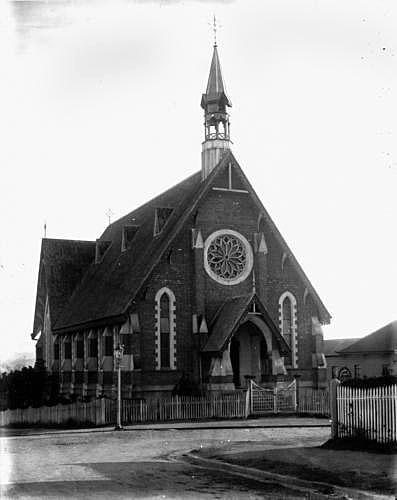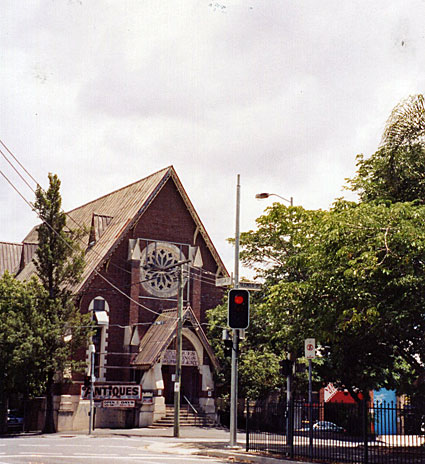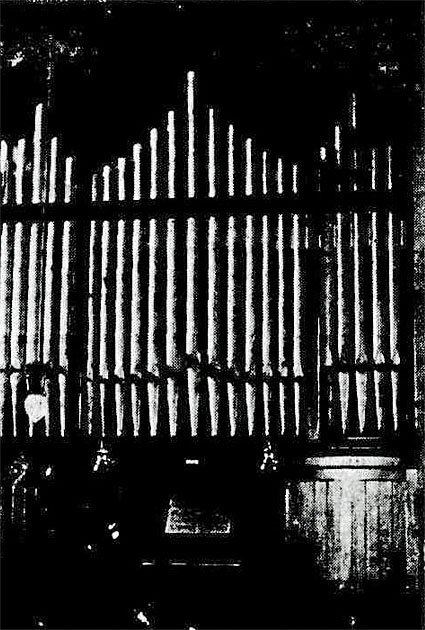
Park Presbyterian Church, Glenelg Street,
South Brisbane, opened in 1885
[Photograph: John Oxley Library, State Library of Queensland]

Park Presbyterian Church, Glenelg Street,
South Brisbane, opened in 1885
[Photograph: John Oxley Library, State Library of Queensland]
Historical and Technical Documentation by Geoffrey Cox
© OHTA 2011 (last updated September 2011)
The name 'Park Church' derives from the location of this church near Musgrave Park in South Brisbane. Like the congregation of the Ann-Street Presbyterian Church (on the north side of the Brisbane River), the Park Church congregation (on the south side) stemmed from the one established in Brisbane in 1849 by the Rev. Thomas Mowbray. They first built a small wooden church in Grey Street, South Brisbane in 1851, but the congregation divided in 1857, some moving to the north side of the river.1 Park Church in Glenelg Street, South Brisbane, was built in 1885 to the design of the Queensland Colonial Architect, F.D.G. Stanley.2
In the early 1950s, the congregation moved to a new church (retaining the name 'Park Presbyterian Church') in Hampstead Road, Highgate Hill, the foundation stone of which was laid on 10 December 1949. The original church in Glenelg Street was subsequently used for a time by the Exclusive Brethren Church, and has since been used for commercial purposes. The Highgate Hill congregation joined the Uniting Church in 1977, and the building was used for a time by the Tongan congregation. It has since been closed.

The former Park Presbyterian Church, Glenelg Street,
South Brisbane, now used for commercial purposes
[Photograph by Geoffrey Cox (2004)]
The organ in the Park Presbyterian Church was built by B.B. Whitehouse & Co. of Brisbane for the church in Glenelg Street. It was opened there on Wednesday 16 July 1913 with a recital by George Sampson, who had also drawn up the specification. Details appeared in The Brisbane Courier at the time of the opening, as follows:
NEW PIPE ORGAN
On Wednesday night last the new pipe organ which has been installed in Park Presbyterian Church by Messrs. B. B. Whitehouse and Co, Brisbane, was opened under the most favourable auspices, by means of a recital given by Mr. George Sampson, F.R.C.O. The instrument, which was designed to Mr. Sampson's specifications, and built with their usual scrupulous care and effective skill by Messrs. Whitehouse, was erected at a total cost of £615, and will doubtless do much to increase the spirit of worship in the psalmody of the church. The specification was as follows:-
Great Organ, CC to A Compass. - 1. Open diapason, 8ft., metal. 2. Stopped diapason, 8ft., wood. 3. Harmonic flute, 4ft., metal. 4. Dulciana (grooved bass), 8ft., metal. 5. Fifteenth, 2ft., metal. 6. Clarionet, 8ft., metal. 7. Trumpet 8ft., metal. Each stop of 58 notes (Nos. 2, 3, 4, 5, and 6 enclosed in a swell box, and three latter stops to be added later on.)
Swell Organ, CC to A Compass. - 8. Double diapason, l6ft., wood and metal. 9. Open diapason, 8ft., wood and metal. 10. Lieblich Gedact, 8ft., wood and metal. 11. Salicional, 8ft., metal. 12. Vox angelica, 8ft, metal. 13. Gemshorn, 4ft., metal. 14. Fifteenth, 2ft., metal. 15. Oboe, 8ft, metal. 16. Cornopean 8ft., metal. Each stop of 58 notes. Nos 8, 12, and 14 to be added later.
Pedal Organ - 17. Bourdon, 16ft., wood 30 notes.
Couplers - 18. Swell sub octave. 19. Super-octave. 20. Swell to great. 21. Great octave. 22. Pedal to great. 23. Pedal to swell. 24. Pedal octave. 25. Tremulant. Two pistons to great organ. Two pistons to swell organ.
The action is tubular pneumatic throughout.3

The new pipe organ in Park Presbyterian Church
[Photograph: The Brisbane Courier (19 July 1913), p. 12]
An unusual feature of the instrument, as mentioned above, was the fact that five of the stops on the Great Organ (excluding the Open Diapason 8ft) were to be enclosed in a swell box. Edward Salisbury, who was organist at this church in the late 1940s, recorded that the pipework was 'totally enclosed' [sic], and that there were 'two swell (lever) pedals, placed together [so as to be] operated with one foot, giving enormous crescendo.' Salisbury also noted that the 'prepared for' stops on the Great Organ were the Fifteenth 2ft, Trumpet 8ft and Clarionet 8ft.4
A Principal 4ft stop was added to the Great Organ in December 1948 by Whitehouse Bros at the cost of £185.5 This was apparently in place of the originally intended Trumpet 8ft, as the specification recorded consistently in later sources was as follows:
| GREAT Open Diapason Stopped Diapason Dulciana Harmonic Flute Principal Fifteenth Clarinet SWELL Double Diapason Open Diapason Lieblich Gedact Salicional Vox Angelica Gemshorn Fifteenth Cornopean Oboe PEDAL Bourdon COUPLERS Swell to Pedal Great to Pedal Swell to Great Great Octave Pedal Octave Swell Sub Octave Swell Super Octave |
8 8 8 4 4 2 8 16 8 8 8 8 4 2 8 8 16 |
[1948] [prepared for] [prepared for] [prepared for] [prepared for] [prepared for] |
Detached stop-key console
3 combination pistons to Great Organ
3 combination pistons to Swell Organ
Radiating concave pedalboard
Balanced swell pedal [replaced earlier hitchdown-lever in 1955]
Swell tremulant
Compass: 58/30
Pneumatic action.6
This was one of the firm's early tubular-pneumatic instruments, and potentially one of their most ambitious. Had the specification been completed according to the original design of 17 stops, this instrument would have been comparable with those built around this time for St Brigid's Catholic Church, Red Hill (1914: 17 stops) and St Mary's Catholic Church, Ipswich (1915+1917: 19 stops). The Park Church organ used cone-pallet chests and featured the 'inclined-block type' stop-keys (placed in a row above the upper manual) that appeared from c.1910 onwards, and which were to remain standard on Whitehouse organs throughout the following four decades.
With the removal of the congregation to Highgate Hill, the organ was dismantled and removed to storage in 1950 prior to being re-assembled in the new church (also known as 'Park Presbyterian') in October 1952.7 The original hitchdown-lever swell pedal was replaced by a balanced swell pedal in March 1955.8
The organ was advertised for sale in March 1997.9 It was removed to storage in Toowoomba around 1998, where it remains under consideration for rebuilding at St Patrick's Catholic Cathedral.10
_________________________________________________________________________
1 Richard Bardon, The Centenary History of The Presbyterian Church of Queensland (Brisbane: W. R. Smith & Paterson, 1949), pp. 19-20, 217, 247; The Brisbane Courier (14 January 1905), p. 12.
2 Donald Watson & Judith McKay, Queensland Architects of the 19th Century: A Biographical Dictionary (Brisbane: Queensland Museum, 1994), p. 173.
3 The Brisbane Courier (19 July 1913), p. 12.
4 Notebooks of Mr E.R. Salisbury.
5 Whitehouse Bros Ledger (1940-54), p. 312.
6 Specification noted by G. Cox, December 1973; Collected Organ Specifications of Bernie Brohan (c.1952).
7 Whitehouse Bros Ledger (1940-54), pp. 384, 224.
8 Whitehouse Bros records, cited in personal communication to G. Cox from Kevin Whitehouse, c.1974.
9 The Organ Voice, vol. 23, no. 1 (March 1997), p. 26.
10 Personal communications to G. Cox from Simon Pierce, January 2001 and March 2003.